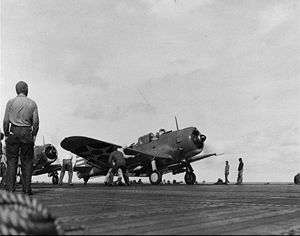Marshalls–Gilberts raids
The Marshalls–Gilberts raids were tactical airstrikes and naval artillery attacks by United States Navy aircraft carrier and other warship forces against Imperial Japanese Navy (IJN) garrisons in the Marshall and Gilbert Islands on 1 February 1942. The Japanese garrisons were under the overall command of Vice Admiral Shigeyoshi Inoue, commander of the 4th Fleet. Japanese aircraft in the islands belonged to the IJN's 24th Air Flotilla under Rear Admiral Eiji Gotō. The U.S. warship forces were under the overall command of Vice Admiral William Halsey, Jr.
Raids
The raids were carried out by two separate U.S. carrier task forces. Aircraft from Task Force 17 (TF 17), commanded by Rear Admiral Frank Jack Fletcher and centered on the carrier USS Yorktown, attacked Jaluit, Mili, and Makin (Butaritari) islands. The Yorktown aircraft inflicted moderate damage to the Japanese naval installations on the islands and destroyed three aircraft. Seven Yorktown aircraft were lost (4 TBD Devastators, 3 SBD Dauntlesses) as well as an SOC Seagull floatplane from USS Louisville, one of TF 17's cruisers.
Aircraft from TF 8, commanded by Halsey and centered on the carrier USS Enterprise, struck Kwajalein, Wotje, and Taroa. At the same time, cruisers and destroyers bombarded Wotje and Taroa. The strikes inflicted light to moderate damage on the three islands' naval garrisons, sank three small warships and damaged several others, including the light cruiser Katori, and destroyed 15 Japanese aircraft. The heavy cruiser USS Chester was hit and slightly damaged by a Japanese aerial bomb, and six Enterprise aircraft - five SBD Dauntless dive bombers and one F4F Wildcat fighter - were lost. Additionally, a float plane from USS Salt Lake City was damaged during recovery and was abandoned and sunk.[1] TFs 8 and 17 retired from the area immediately upon completion of the raids.
Aftermath and significance
The raids had little long-term strategic impact. The IJN briefly sent two aircraft carriers to chase TFs 8 and 17, but quickly abandoned the pursuit and continued their support for the ongoing successful conquests of the Philippines and Netherlands East Indies. The raids, however, did help lift the morale of the U.S. Navy and the American public, still reeling from the Pearl Harbor attack and loss of Wake Island. The raids also provided valuable experience in carrier air operations, which hardened the U.S. carrier groups for future combat against Japanese forces.[2] For their part the Japanese apparently did not realize that their concept of a perimeter defense using dispersed island garrisons had serious flaws in that the garrisons were too far apart to be sufficiently mutually supporting to prevent penetration by enemy carrier forces. Nevertheless the raids, along with the Doolittle Raid in April 1942, helped convince the IJN's Combined Fleet commander, Isoroku Yamamoto, that he needed to draw the American carriers into battle as soon as possible in order to destroy them. Yamamoto's plan to do so resulted in the Battle of Midway.
References
Notes
- "Marshalls-Gilbert Raid After Action Report". ibibio.org. Naval History and Heritage Command. Retrieved 11 October 2019.
- Parshall, Jonathan; Tully, Anthony (2005). Shattered Sword: The Untold Story of the Battle of Midway. Dulles, Virginia: Potomac Books. p. 42. ISBN 1-57488-923-0.
Books
- Cressman, Robert (2000). That Gallant Ship U.S.S. Yorktown (CV-5). Missoula, Montana, U.S.A.: Pictorial Histories Publishing Company. ISBN 0-933126-57-3.
- Lundstrom, John B. (2005). The First Team: Pacific Naval Air Combat from Pearl Harbor to Midway (New ed.). Annapolis, Maryland, U.S.A.: Naval Institute Press. ISBN 1-59114-471-X.
- Lundstrom, John B. (2006). Black Shoe Carrier Admiral: Frank Jack Fletcher at Coral Seas, Midway & Guadalcanal. Annapolis, Maryland, USA: Naval Institute Press. ISBN 1-59114-475-2.
- Morison, Samuel Eliot (2001) [1958]. The Rising Sun in the Pacific 1931 – April 1942, vol. 3 of History of United States Naval Operations in World War II. Castle Books. ISBN 0-7858-1304-7.
- Stafford, Edward P. (2002). The Big E: The Story of the USS Enterprise (reissue ed.). Naval Institute Press. ISBN 1-55750-998-0.
- Willmott, H. P. (1982). Empires in the Balance: Japanese and Allied Pacific Strategies to April 1942. Annapolis, Maryland: Naval Institute Press. ISBN 0-87021-535-3.
- Willmott, H. P. (1983). The Barrier and the Javelin: Japanese and Allied Pacific Strategies February to June 1942. Annapolis, Maryland: Naval Institute Press. ISBN 0-87021-535-3.
Web
| Wikimedia Commons has media related to Marshalls-Gilberts raids. |
- Hackett, Bob, and Sander Kingsepp (1998–2007). "HIJMS Katori: Tabular Record of Movement". Junyokan!. Combinedfleet.com.
- United States Navy, Office of Naval Intelligence (1943). "Early Raids in the Pacific Ocean: February 1 to March 10, 1942". Combat Narrative. Publication Section, Combat Intelligence Branch.
- USS Enterprise photo archive of the raid
